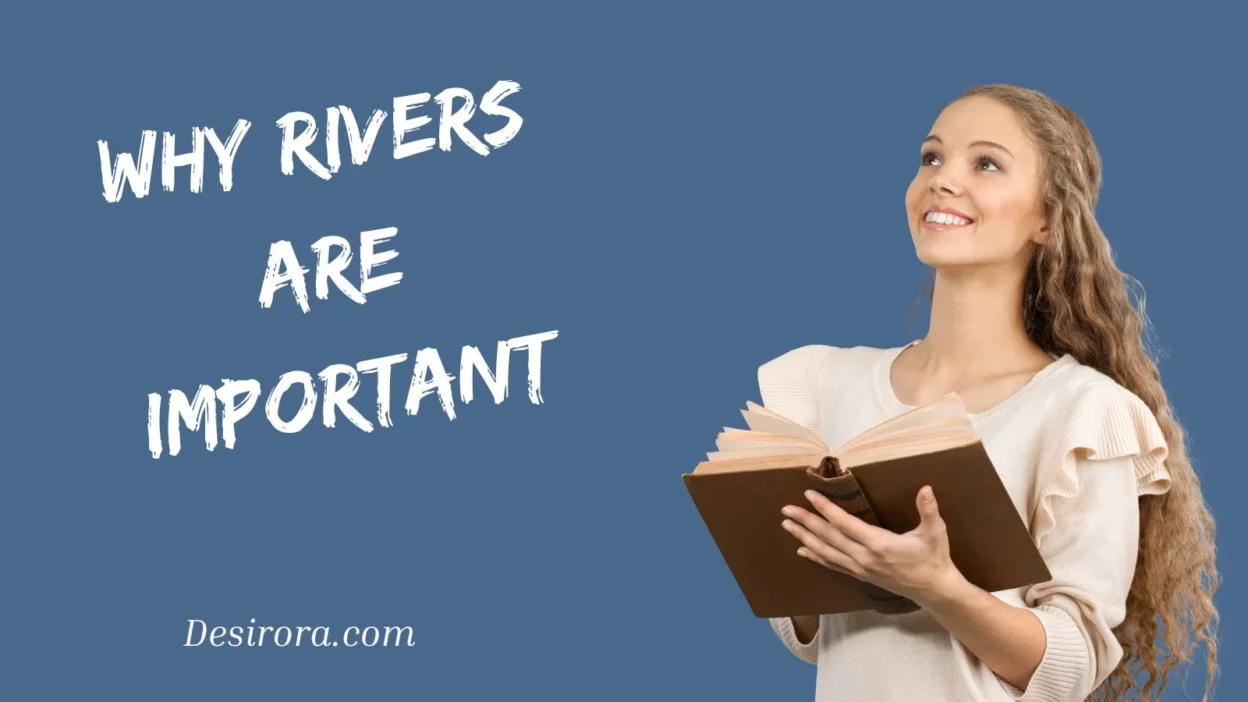Rivers have always been more than just flowing bodies of water. They’re the arteries of our Earth, carrying life, culture, history, and hope along their banks. From the Amazon River in South America to the Ganges in Asia, rivers have nurtured civilizations, fueled economies, and sustained biodiversity for millennia.
But in today’s world, their importance goes far beyond drinking water or farming—they connect us to nature, provide energy, and even influence the climate.
In this article, we’ll explore why rivers are important, not only for humans but for all life on Earth.
The Ancient Bond Between Rivers and Civilizations
Our ancestors knew something profound: no river, no life. Early civilizations like those along the Nile in Egypt, the Tigris and Euphrates in Mesopotamia, and the Yellow River (Huang He) in China flourished because of rivers. They provided:
- Fertile soil from annual flooding, crucial for crops.
- Transport routes for trade and exploration.
- Spiritual meaning, often worshipped as deities.
The Romans built aqueducts, the Saxons and Britons settled by rivers in Britain, and even today, London’s River Thames is an economic and cultural connector.
As historian Mark Angelo once said:
“Rivers are the great connectors—of people, places, and time itself.”
Rivers as Sources of Freshwater and Drinking Water
Freshwater is a finite and fragile resource. Out of all the water on Earth, less than 3% is freshwater, and only a small portion is accessible through rivers and lakes.
- Rivers supply drinking water to billions of people.
- They recharge aquifers and underground reservoirs.
- Communities in Africa, Asia, and South America rely on rivers daily for cooking, bathing, and sanitation.
Example: The Amazon River in Brazil carries about 20% of the world’s freshwater flow, making it a lifeline not only for South America but globally.
But with rising pollution from plastics, pesticides, and chemicals, the purity of rivers is under pressure. That’s why groups like WWF and IUCN advocate for clean rivers as essential for human survival.
The Role of Rivers in Agriculture and Food Security
Without rivers, farming as we know it wouldn’t exist. Irrigation systems—both ancient and modern—depend heavily on them.
- Rivers bring nutrient-rich sediments (alluvium) that make lands fertile.
- They provide controlled irrigation for crops like rice in Asia, wheat in Europe, and maize in Africa.
- Rivers support fisheries, supplying vital protein to billions.
Case study: The Nile Delta in Egypt is among the most fertile regions on Earth, thanks to the river’s seasonal floods. Even in modern times, irrigation ditches and canals allow Egypt to feed its people despite a largely desert landscape.
Here’s a quick look at how rivers boost agriculture:
| Benefit | Example | Impact |
| Fertile soils | Ganges Basin (India) | Feeds 500M people |
| Irrigation | Mekong (Vietnam, Laos, Cambodia) | Rice farming hub |
| Fisheries | Mississippi River (USA) | Freshwater catfish, trout |
| Livestock water | African rivers | Supports cattle, goats |
Economic Importance: Trade, Transport, and Livelihoods
Historically, rivers have been trade highways. They still are.
- The Danube in Europe connects 10 countries, making it one of the most crucial trade routes.
- The Mississippi in the USA supports massive commercial transport of grain, oil, and goods.
- In Asia, the Yangtze in China and Mekong in Southeast Asia power entire economies.
Rivers also provide jobs in:
- Fishing and aquaculture
- Hydroelectric energy production
- Tourism and boating
- Lumber and goods transportation
Think of the Amazon River basin in Brazil: home to millions, it supports timber, agriculture, fishing, and tourism industries—a true economic engine.
Rivers and Biodiversity: Habitats Full of Life
Rivers are biodiverse ecosystems, hosting countless plants, animals, and microorganisms.
- Amphibians like frogs rely on riverbanks for breeding.
- Birds (from kingfishers to migratory geese) use rivers for nesting and feeding.
- Fish such as salmon, trout, carp, and eels depend on river cycles for spawning.
- Rivers connect to wetlands, estuaries, and mangroves, forming crucial habitats.
Fun fact: The Amazon River basin alone is home to over 2,200 species of fish—that’s more than the entire Atlantic Ocean!
Yet biodiversity is under threat due to overfishing, invasive species, and polluted waters. Protecting rivers means protecting the web of life.
Cultural, Spiritual, and Historical Significance of Rivers
Rivers aren’t just physical—they’re spiritual and cultural symbols.
- The Ganges River is sacred to Hindus, seen as a goddess and purifier.
- The Shinto tradition in Japan regards rivers as sacred spirits.
- Ancient civilizations celebrated rivers through festivals and rituals.
Even today, people celebrate World Rivers Day, inspired by Mark Angelo, to raise awareness of their importance.
Rivers inspire art, literature, and even product branding. (Fun fact: Budweiser’s parent company, AB InBev, runs water conservation programs because without clean water, there’s no beer!)
Rivers in Modern Development: Energy and Industry
In today’s world, rivers generate renewable energy and power industries.
- Hydroelectric dams like the Three Gorges Dam (TGD) on the Yangtze supply electricity to millions.
- Rivers support factories and businesses by providing water for production and cooling.
- Cities like London, Paris, and New York developed around rivers for industrial access.
But it’s a balancing act. While hydroelectric turbines provide power, they also disrupt ecosystems and fish migration. That’s why modern restoration and monitoring programs aim to balance development with conservation.
Environmental Functions: Climate, Flood Control, and Soil Fertility
Rivers shape landscapes and environments.
- They moderate temperatures and regulate local climates.
- Floods, though destructive, also bring nutrient-rich soils that boost agriculture.
- Rivers recharge wetlands and aquifers, ensuring ecosystems stay alive.
- They carry nutrients, sediments, and organic matter, feeding coastal ecosystems.
Example: The Mississippi floodplains are among the most fertile lands on Earth, supporting massive farming economies.
Yet, when rivers are degraded—through pollution or dams—this natural cycle breaks, leading to erosion, desertification, and loss of biodiversity.
Tourism, Recreation, and Human Well-being
Rivers also fuel joy. They give us:
- Recreation: swimming, kayaking, rafting, fishing.
- Tourism: The Nile cruises in Egypt, Rhine tours in Europe, and Mekong trips in Vietnam.
- Mental health benefits: studies show being near water reduces stress and boosts happiness.
Quote from Graham Lawton (New Scientist):
“Blue spaces like rivers are not just scenery—they’re medicine for the human mind.”
Threats Facing Rivers: Pollution, Overuse, and Climate Change
Sadly, rivers today are under siege.
- Pollution: chemicals, plastics, pesticides, and industrial waste poison rivers.
- Overuse: excessive irrigation, drinking water demands, and industrial withdrawals.
- Climate change: glaciers melting, rainfall patterns shifting, droughts drying rivers.
- Overfishing: threatens aquatic species like salmon, trout, and carp.
Example: The Rwizi River in Uganda has been degraded by pollution from tanneries and factories, threatening local communities.
Unless restoration, advocacy, and regulation are prioritized, many rivers face irreversible damage.
Global Efforts in River Conservation and Restoration
Thankfully, organizations and governments are stepping up.
- WWF and UNEP run global freshwater protection campaigns.
- Local community clean-ups reduce plastics and pollutants.
- River restoration projects (like those in Britain and France) revive salmon habitats.
- Environmental laws set standards for water quality and usage.
Rivers are not just environmental issues—they’re about security, livelihoods, and survival. Protecting them means protecting ourselves.
Why Protecting Rivers Means Protecting Ourselves
Rivers are life, culture, and economy wrapped into one. They give us food, water, energy, trade, and beauty. They’re home to birds, fish, and countless organisms. They inspire cultures, traditions, and spiritual practices.
To lose our rivers is to lose our past, present, and future.
FAQs
Q1: Why are rivers called the lifelines of civilization?
Because they provide water, fertile soil, transport, and resources that sustain human societies and biodiversity.
Q2: How do rivers affect the economy?
They support agriculture, fisheries, transport, energy, and tourism, creating millions of jobs worldwide.
Q3: What are the major threats to rivers today?
Pollution, overuse, climate change, dam construction, and overfishing are the biggest risks.
Q4: Which river is the longest in the world?
The Nile River is traditionally considered the longest, though the Amazon River rivals it in length and flow.
Q5: How can we protect rivers?
Through clean-up drives, reducing plastic use, enforcing environmental laws, sustainable farming, and supporting global advocacy groups.
Conclusion
Rivers aren’t just natural features—they’re the beating heart of our world. They carry history, culture, biodiversity, and economic strength in their flow. From the snow-fed Himalayas feeding the Ganges to the Amazon’s powerful currents, rivers remind us of our deep connection to water and life.
Protecting rivers isn’t charity—it’s survival. The next time you stand by a flowing river, remember: it’s not just water passing by, it’s life itself, alive and flowing.

Aldous Huxley was a visionary writer and philosopher whose works explored human nature, consciousness, and the future of society. His ideas continue to challenge minds and inspire generations.



